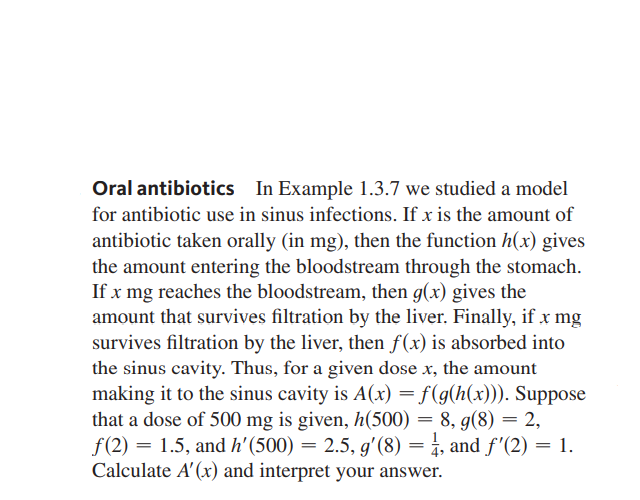Oral antibiotics In Example 1.3.7 we studied a model for antibiotic use in sinus infections. If x is the amount of antibiotic taken orally (in mg), then the function h(x) gives the amount entering the bloodstream through the stomach. If x mg reaches the bloodstream, then g(x) gives the amount that survives filtration by the liver. Finally, if x mg survives filtration by the liver, then f(x) is absorbed into the sinus cavity. Thus, for a given dose x, the amount making it to the sinus cavity is A(x) = f(g(h(x))). Suppose that a dose of 500 mg is given, h(500) = 8, g(8) = 2, f(2) = 1.5, and h'(500) = 2.5, g'(8) Calculate A' (x) and interpret your answer. = 4, and f'(2) = 1.
Oral antibiotics In Example 1.3.7 we studied a model for antibiotic use in sinus infections. If x is the amount of antibiotic taken orally (in mg), then the function h(x) gives the amount entering the bloodstream through the stomach. If x mg reaches the bloodstream, then g(x) gives the amount that survives filtration by the liver. Finally, if x mg survives filtration by the liver, then f(x) is absorbed into the sinus cavity. Thus, for a given dose x, the amount making it to the sinus cavity is A(x) = f(g(h(x))). Suppose that a dose of 500 mg is given, h(500) = 8, g(8) = 2, f(2) = 1.5, and h'(500) = 2.5, g'(8) Calculate A' (x) and interpret your answer. = 4, and f'(2) = 1.
Functions and Change: A Modeling Approach to College Algebra (MindTap Course List)
6th Edition
ISBN:9781337111348
Author:Bruce Crauder, Benny Evans, Alan Noell
Publisher:Bruce Crauder, Benny Evans, Alan Noell
Chapter5: A Survey Of Other Common Functions
Section5.4: Combining And Decomposing Functions
Problem 14E: Decay of Litter Litter such as leaves falls to the forest floor, where the action of insects and...
Related questions
Question

Transcribed Image Text:Oral antibiotics In Example 1.3.7 we studied a model
for antibiotic use in sinus infections. If x is the amount of
antibiotic taken orally (in mg), then the function h(x) gives
the amount entering the bloodstream through the stomach.
If x mg reaches the bloodstream, then g(x) gives the
amount that survives filtration by the liver. Finally, if x mg
survives filtration by the liver, then f(x) is absorbed into
the sinus cavity. Thus, for a given dose x, the amount
making it to the sinus cavity is A(x) = f(g(h(x))). Suppose
that a dose of 500 mg is given, h(500) = 8, g(8) = 2,
f(2) = 1.5, and h'(500) = 2.5, g'(8)
Calculate A' (x) and interpret your answer.
= 4, and f'(2) = 1.
Expert Solution
This question has been solved!
Explore an expertly crafted, step-by-step solution for a thorough understanding of key concepts.
This is a popular solution!
Trending now
This is a popular solution!
Step by step
Solved in 2 steps with 2 images

Recommended textbooks for you

Functions and Change: A Modeling Approach to Coll…
Algebra
ISBN:
9781337111348
Author:
Bruce Crauder, Benny Evans, Alan Noell
Publisher:
Cengage Learning

Algebra & Trigonometry with Analytic Geometry
Algebra
ISBN:
9781133382119
Author:
Swokowski
Publisher:
Cengage

College Algebra
Algebra
ISBN:
9781305115545
Author:
James Stewart, Lothar Redlin, Saleem Watson
Publisher:
Cengage Learning

Functions and Change: A Modeling Approach to Coll…
Algebra
ISBN:
9781337111348
Author:
Bruce Crauder, Benny Evans, Alan Noell
Publisher:
Cengage Learning

Algebra & Trigonometry with Analytic Geometry
Algebra
ISBN:
9781133382119
Author:
Swokowski
Publisher:
Cengage

College Algebra
Algebra
ISBN:
9781305115545
Author:
James Stewart, Lothar Redlin, Saleem Watson
Publisher:
Cengage Learning